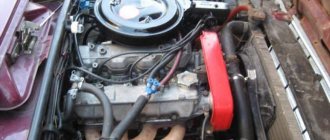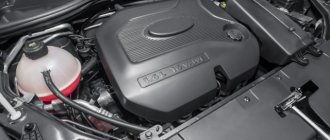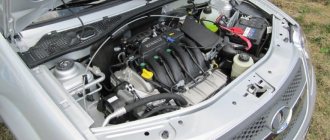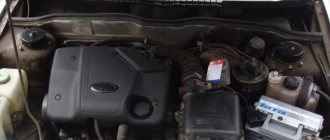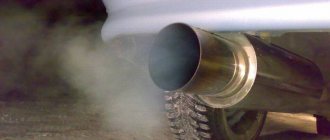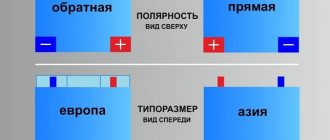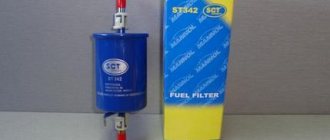Domestic modifications of Lada Vesta car models are equipped with a wide selection of engines that have a similar layout and are built on the basis of a standard block.
In addition to Russian engine options, the manufacturer offers products from the popular global alliance Renault-Nissan.
Each engine has its own advantages, which are selected by customers based on individual requirements and price ratio.
Related Posts
The reason why AvtoVAZ excludes the 1.8 engine from the Lada Vesta
The whole truth about Lada Xray in one review
Description of engines 1.6 and 1.8
AvtoVAZ manufacturers initially equipped the cars with three subtypes of engines specially created for Vesta: 2 of which were 1.6 liters, labeled as 21127 and 21129, and the third with an operating power of 1.8 liters (21179). After some time, the 27th engine was supplanted by the modernized 29th. The main reason for the abandonment of this engine was its non-compliance with Euro-4 environmental standards and, despite the rather good characteristics of the unit designed by the plant’s engineers, it was completely discontinued and replaced by an updated version of the 29th.
The modified Lada Vesta engine was equipped with the following innovations:
— the modified engine became 16-valve; — the weight of components has been reduced; — the control unit controller (ECM – M86) was re-flashed; — the exhaust system and the resonance starting system were modified; — manufacturers reduced the compression ratio to 10.45; — the installation was equipped with hydraulic compensators; — The engine cooling system has been modernized.
Thanks to the modernization, the 21129 unit is endowed with a longer service life - 250 thousand km, compared to 200 thousand declared for the 21127 engine. The more powerful 1.8 engine was developed with the help of foreign engineers and received the following modifications:
— enlarged piston; — replacing the timing belt with a chain; — the radius of the crank mechanism links has been increased; — The oil channels have been modified.
Both power plant options available today have similarities, differences, and individual pros and cons.
Engine assembly materials 1.8 Lada Vesta SV Cross
Let's continue our analysis of the engine. Next, we suggest you take a more in-depth look at the parts from which this motor is assembled. Parts List:
- The timing belts used in these engines are manufactured by Continental. The declared belt resource is 180 thousand km. How truthful this can only be learned from the owners of Vesta Cross SV or from our own experience;
- Continental also supplies injectors. This model of nozzles has a longer life and increased performance;
- valves from Mahle;
- pump from GMB. Its resource corresponds to the timing belt and is the same 180 thousand km;
- an oil pump from GMB is also used;
- but the installed camshafts were manufactured by Toyota Tsusho. They compare favorably with the old ones in weight;
- INA phase adjustment mechanism.
Comparison of engine specifications
1. Motor power. The 1.6 engine, of course, is inferior to the 1.8 engine in power and speed indicators. 21129 is endowed with a power of 78 kW, which corresponds to 106 hp, while the figures for 21179 come down to 90 kW (122 hp). 2. Torque. The ratio of the volume of the combustion chambers of the 1.6-liter engine is inferior to 21179, so this figure for 21129 is reduced to 148 nm, and for the 1.8-liter unit it reaches 170 nm. 3. Maximum speed. Thanks to more power and maximum torque, the speed characteristics of the 1.8-liter engine are higher. The 21179 can reach a top speed limit of 180 km/h, while the maximum speed of the 21129 is 172 km/h. 4. Overclocking. Lada Vesta with a 29 engine is capable of accelerating to a speed of 100 km/h in 12.6 seconds. The 1.8-liter engine is almost one and a half seconds ahead of this figure - 11.2 s. 5. Fuel consumption. The 1.6-liter unit is more profitable in terms of gasoline consumption: 9.7 liters per 100 km of driving in urban conditions and 7.5 in mixed mode. When driving exclusively on the highway, this engine will consume only 5.3 liters. The 1.8-liter engine is less economical in these characteristics: 10.3 liters in the city, 7.9 on mixed roads, 5.8 liters on the highway. Each owner selects a vehicle with the most individually acceptable power of the power unit. Each of Vesta’s two engines has both advantages and disadvantages, which play an important role when buying a car.
Pros and cons of Lada Vesta with a 1.6 engine
The advantages of this engine variation for the Lada Vesta include: environmental friendliness, smoothing of shock loads through the presence of hydraulic compensators, economical fuel, oil, and liquid consumption (compared to a 1.8-liter unit), accessible and cheaper repairs and maintenance, the ability to perform overhauls independently, modernized attachments. In addition, this engine has already become time-tested and used by car owners. If we talk about its shortcomings, then these can easily be attributed to more frequent replacement of consumables and a less smooth ride.
Pros and cons of Lada Vesta with a 1.8 engine
The car is endowed with the following advantages: smoother ride, improved cooling system, modified installation control unit, higher speed, acceleration (even when the vehicle is loaded). The disadvantages include less economical fuel consumption, increased oil consumption, engine noise, less environmental friendliness (despite the fact that this engine, along with the 1.6-liter, belongs to the Euro-5 environmental class), the need to replace the timing belt every 90 thousand km and large material costs when carrying out repair work. This type of engine is still in the experimental stage of development, although it is actively used in new domestic Vesta.
As for the price category of the two vehicles, the price for Vesta with a 1.8 engine is higher, but not significantly - only 25-30 thousand rubles.
Which motor oil to choose?
In order not to make a mistake when choosing engine oil for Vesta SW Cross, as is the case with other cars, you need to clearly understand the conditions under which the car will operate. First of all, you need to choose the appropriate viscosity of the engine oil. The operating instructions say that the following types of oils are suitable for this engine:
- 5W-30;
- 5W-40;
- 10W-40;
- 15W-40.
And this is where the nuances mentioned above begin. So, for example, if the car is operated in colder regions, it is better to give preference to liquid oils: 5W-30 or 5W-40. And if the engine is new and has low mileage, it is allowed to use oil with 0W-40 ratings.
If you live in a warm region or use your car exclusively in the spring and summer, you can safely fill in 10W-40 and 15W-40 oils.
Next, you need to select the optimal quality class. Again, according to the operating instructions, it is recommended to use oils of at least SM class according to API or GF-4 according to ILSAC.
As for the manufacturer, it’s hard to say for sure. Everyone decides for himself which manufacturer he trusts more. In the end, it is not the manufacturer himself that is important, but the ability of his product to meet the required standards.
Do valves bend if the timing belt breaks?
Like all modern engines, if the belt breaks, the Vesta engine will bend the valves. This is due to the fact that manufacturers are trying to achieve maximum power levels in new vehicles, despite the very modest volumes of some models. To achieve this, the elements of the connecting rod and piston group are made as light as possible, while at the same time, the compression parameter is increased as much as possible. Thus, it is impossible to achieve grooves in the pistons. So if the pump or tension roller jams, or when the timing belt breaks, you will need to do a major overhaul of the engine.
Main components
Among the most important elements of this motor, the following should be highlighted:
- valves from the famous Mahle brand;
- Continental timing belt. According to the manufacturer, the service life of this component reaches up to 180 thousand kilometers. In practice, the figure is somewhat smaller, but still very impressive;
- injectors from the same manufacturer. When compared with Priora, the resource here is several times higher, and the performance is somewhat better;
- GMB pumps. Its service life corresponds to the timing belt (180,000 kilometers);
- Toyota Tsusho camshafts. Their weight is an order of magnitude lower than in the case of old cast iron models;
- INA phase adjustment mechanism.
It will also be interesting to read: Mercedes GLE 2021: photos, configurations and prices
Fuel consumption of Lada Vesta SW and SW Cross
Lada Vesta SW
Comparing the tables, you can see that a Vesta station wagon consumes more fuel than a sedan, this is due to many factors. Firstly, the Vesta station wagon has more mass, which has a detrimental effect on fuel consumption; the aerodynamics of the car have also changed, not for the better, compared to the sedan. There are many more factors that could indirectly affect the car’s consumption, but the fact remains that the car consumes significantly more fuel than its predecessor.
Lada Vesta SW Cross
The most economical car of the Lada Vesta family is rightfully recognized as a station wagon with a cross modification. A small change in dimensions and a significant increase in ground clearance also affected the car’s fuel consumption, adding an average of 100 milliliters per 100 kilometers to the indicators of all trim levels.
Manual transmission options on Vesta
When developing this car model, the use of the “native” gearbox, the VAZ 2180, was initially envisaged. However, the former director of AvtoVAZ, Bo Andersson, rejected it due to the hum that occurs when the gears rotate and interact. Instead of the originally planned gearbox, a Renault JH3 manual was installed.
After carrying out the necessary work on the domestic gearbox, the designers managed to reduce noise and also create a more balanced gear shift pattern. After the improvements have been made on the Lada Vesta, the manual gearbox is again installed domestically. It is marked as VAZ 21087.
The new transmission has slightly different characteristics. The gear ratio is 3.94. The car can be accelerated to hundreds in 10.2 seconds, and the top speed has increased to 188 km/m. At the same time, the volume of fuel consumed has also increased slightly. Now it is 7.5 liters per 100 km. in a mixed driving cycle.
What kind of oil is recommended for Lada Vesta?
Regarding savings, the manufacturer recommends filling in SAE 5W30 or SAE 5W40 oil of domestic brands:
The plant calls foreign manufacturers an alternative oil for Vesta with the characteristic 5w30:
- Mobil (5w40 is also allowed, and for new cars 0w40);
- Motul Specific DEXO s2;
- Shell HELIX HX8.
It is precisely with its lower power and volume that the 1.6-liter engine turned out to be a more economical option, because its fuel consumption is slightly lower than that of its opponent: 9.3 liters - in the city; 5.5 – on the highway; 6.9 – in mixed mode (versus 10.2/6.5/7.5 for the 1.8-liter, respectively).
Now let’s move on from dry and boring numbers to a more lively “interior”. As for the drive, there are as many as three options: the larger engine has a timing belt from the German company INA (and as you know, there is no doubt about the quality of German products), the standard 1.6-liter power unit has a regular timing belt, but There is also a similar engine from the Nissan concern H4M (with a power of 110 hp, many sources indicate 114 hp, but this is incorrect), on which a chain is already installed.
In the latter case, we can talk about the “golden mean” between quality and efficiency. Although, in the case of the practicality of the drive, the Nissan engine “jumped ahead” of both of its brothers - here you can save on consumables (the chain is, however, more expensive, but it lasts much longer, there is no possibility of bending the valves).
Fuel consumption figures
In addition, when choosing a vehicle, many car owners are interested in its efficiency. It is worth noting that this engine can run on both 92 and 95 gasoline. At the same time, the fuel consumption figures for this engine are:
- driving around the city - 10.7 liters with a manual and 10.1 liters with an automatic;
- driving on the highway - 6.4 liters. Manual transmission and 6.3 l. automatic transmission;
- mixed cycle - 7.9 l. manual gearbox and 7.7 automatic transmission.
In principle, it cannot be said that the power unit is very economical. At the same time, these are quite good indicators for driving on the highway.
Main disadvantages of the motor
It is worth noting that, although manufacturers took into account the shortcomings of the 21128 engine from the Lada Priora Sport, this engine also has a number of shortcomings. The motor has been available for use for about 2 years, so users have been able to evaluate all its strengths and weaknesses. First of all, it needs to be emphasized here:
- extraneous noise from hydraulic compensators. In principle, knocking noises from this unit are a typical problem with all 16-valve engines made by AvtoVAZ. Basically, the problem occurs due to the fact that there is not enough working fluid in the power unit (it hasn’t been added for a long time, or there is a leak). In addition, the same symptom appears when using low quality oil. If you run everything too hard, you will have to completely replace the hydraulic compensators. It is worth noting that there is nothing wrong with this, since such repairs will cost you very little;
- increased consumption of working fluid. Motors of this type consume quite a lot of oil. As a rule, this occurs in the event of a failure of the connecting rod and piston group. You can get out of this situation only if you completely replace the faulty elements.
It will also be interesting to read: Zotye SR9: Porsche's Chinese twin
In principle, there are no further special comments regarding the functioning of the Lada Vesta Cross engine. If you maintain it correctly, the unit will last up to 200 thousand kilometers without problems. At the same time, the engines demonstrate excellent performance with both a manual gearbox and automatic transmission. By the way, the resource of the latter is exactly the same as that of the mechanics.
